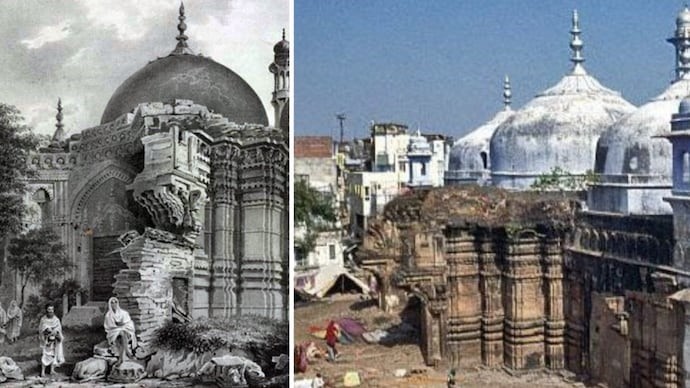The Sacred Geometry of Kashi Gyanvapi Vishveshvar Temple Spiritually Endowed to Enrich Transcendental Bliss on Maha Shivaratri
- In Religion
- 10:32 PM, Mar 07, 2024
- Rudra Dubey
Shiva and Shakti together define the whole universe and the entire creation, being non-being, seen, unseen, we see and experience. The Union of Shiva and Shakti is the divine source of all life. The lifecycle continues with destructible reincarnation, but the indestructible soul seeks the source, the origins, and that is the spiritual process. On Mahashivaratri union of Shiva and Shakti occurred to give an origin to the universe, it is considered one of the most divine nights to achieve merging being, the Brahm with the source, Param Brahm. It is believed that, on Maha Shivaratri the earth witnesses an increase in energy levels and Kundalini Shakti that resides in our body is gently and naturally rising to trigger awakening.
Jyotirlingas holds immense significance in Hinduism. Of 12 Jyotirlings, the Adi Vishveshvar Jyotirlinga at Kashi (Varanasi, India) is believed to be the oldest and most ancient Jyotirlinga, with its origins traced back to the Puranic age. Adi Vishveshvar Jyotirlinga represents the union of God Shiva and Goddess Parvati, symbolizing the eternal union of masculine and feminine energies. It is believed that the Jyotirlingas were created by Shiva to commemorate the creation of the universe and become a place where Brahm may seek and meet Param Brahm.
Shri Yantra, also known as the Sri Yantra, is associated with the creation of the universe and the manifestation of the divine. The Shri Yantra represents the cosmic womb, where the universe and all living beings originate. Shri Chakra is a sacred geometric symbol representing the cosmos and the journey to enlightenment. Shiva and Shakti symbolize the unity of masculine and feminine energies. Shiva represents consciousness, while Shakti embodies the dynamic energy of creation, and it can be interpreted that their union is represented in the Shri Yantra triangle which signifies the harmonious balance and interdependence of these opposing forces. This union of Shiva and Shakti represents the eternal cycle of creation, preservation, and destruction, reminding us of the cyclical nature of life and the universe. The triangle itself points upwards, indicating the ascension of energy and consciousness towards enlightenment.
The vast tapestry of Hindu belief of spirituality and temple architecture with eternal structure is more than embellishment, as it weaves a narrative that transcends the boundaries of time and space. These sacred symbols and structures hold profound significance, representing the cosmic dance of creation, the union of divine energies, and the spiritual journey of devotees seeking enlightenment. The quest to perceive Brahm in Brahmand (universe), delves us into decoding the divine symbolism encoded in the understanding of the manifestations of Bhagwan Shiva in Jyotirlingas, the sacred geometry of Shri Yantra, and esoteric architectures of Hindu temples. The Sri Yantra architecture in the temple is a connotation of a union of masculine and feminine and represents the harmony and balance of opposites in the universe, the Shiva and Shakti. By worshipping in a temple that represents the union of Shiva and Shakti on Shiva Ratri, devotees can connect with the divine energies and experience spiritual growth and transformation.
Adi Vishveshvar Jyotirlinga at Gyanvapi Kashi is the Purest Manifestation of Bhagwan Shiva
The Jyotirlingas are revered as powerful and sacred sites where Bhagwan Shiva, where he is believed to have manifested in various forms. According to the legends, Shiva created the Jyotirlingas to commemorate this cosmic event and serve as a perpetual reminder of his divine presence. In this sense, Jyotirlingas play pivotal roles in the creation and evolution of the universe, representing powerful symbols of the divine and offering pathways for spiritual growth and enlightenment.
Adi Vishveshvar Jyotirlinga, also known as Kashi Vishvanath, is the most revered Jyotirlingas and holds immense significance in Hinduism. Adi Vishveshvar Jyotirlinga has eternal existence, and it is believed to be the oldest and most ancient Jyotirlinga, with its origins traced back to the Puranic age. The Jyotirlinga is situated in the city of Varanasi, which is considered one of the holiest cities in Hinduism, on the banks of the sacred River Ganges. Spiritual
Kashi Vishvanath is considered a gateway to spiritual enlightenment and self-realization, attracting millions of devotees and spiritual seekers. The Adi Vishveshvar Jyotirlinga is associated with the cosmic sound 'AUM' or 'Pranav', which is considered the sound of creation and the universe, and believed to be connected to the cosmos, representing the macrocosm and the microcosm. The union of Shiva and Shakti is reflected in the union of being with the universe.
"Aum sahasrara-padma-nabhya-hridayaya vishvateeta-maha-shunya-yogi- Hrida-ya-akaasha-vasiny-adhikaara-yogi Aum" (Mundaka Upanishad).
Brihadaranyaka Upanishad, one of the oldest scriptures in Hinduism, emanated from Yajur Veda, and unraveled the ultimate reality of the union in shloka “Aham Brahmasmi” (I am Brahman). This shloka is the essence of Advaita Vedanta and eludes the concepts of Atman and Brahman. The most remarkable aspect is that it represents the union of Bhagwan Shiva and Maa Parvati, symbolizing the eternal union of masculine and feminine energies. Since Adi Vishveshvar Jyotirlinga at the Gyanvapi, Kashi is the most powerful symbol of the divine, cosmic energy, and spiritual growth therefore it is the most revered place on earth to worship Shiva and Parvati on the Shiva Ratri.
The Shri Yantra Represents Cosmic Womb and Symbol of Divine Unity
The Shri Yantra, also known as the Sri Yantra or Shri Chakra, stands as a sacred geometric symbol in Hinduism, intricately connected to the creation of the universe and the manifestation of the divine. According to legend, Maa Lalita Tripurasundari created the Shri Yantra to bring order to the cosmos and facilitate spiritual evolution.
This mystical symbol, consisting of nine interconnected triangles, represents the cosmic womb from which the universe and all living beings originate. The nine interlaced triangles comprise four upward triangles concentrically aligned to five downward triangles to form a star tetrahedron.
The nine triangles are surrounded by two symmetrically distributed layers of 8 and 19 lotus petals. The Sri Yantra is the two-dimensional visual equivalent of the sound OM (the hum of the universe). Sri Yantra creates a navigational path for the soul’s journey, starting from a square, petals, nine concentric levels of triangles and all the way radiating into the central point (Bindu)- which is believed to be the union of Brahm to Param Brahm. The specific numbers and shapes in Shri Yantra are rooted in sacred geometry, symbolism, and spiritual significance. The triangles numbers represent the fundamental principles of the universe: 4 triangles represent stability (earth elements) and 5 triangles represent change (ether elements). The opposing triangles symbolize the harmony and dynamism in these principles. The 8 lotus petals represent the 8 aspects of Shakti (divine feminine energy) and the 16 lotus petals represent the 16 kalas (aspects) of Shakti. Lotus petals symbolize the unfolding of creation from the cosmic womb, spiritual growth, unfolding, and expansion.
Shri Yantra represents the harmony and balance of opposites in the universe and its geometric pattern is thought to mirror the structure of the universe, with its intricate relationships and interconnectedness. The Sri Yantra's design not only reflects the cycles and rhythms of the universe, such as the cycles of creation, preservation, and destruction, but it also represents the diversity and unity of the universe. The Sri Yantra is believed to represent and harness the energies (the Shakti) of the universe, channeling them for spiritual growth and manifestation (the Shiva).
The four-pointed triangle, also known as the Shiva Kona, represents Shiva, the masculine principle, and is associated with stability, consciousness, and the four Vedas. The five-pointed triangle, or Shakti Kona, represents Shakti, the feminine principle, and is associated with creativity, energy, and the five elements. The opposition between these triangles symbolizes the eternal dance of Shiva and Shakti, the harmony and tension between masculine and feminine energies. Together, they create a dynamic balance, reflecting the universe's cycles and the unity of opposites. The 8 and 16 lotus petals represent the unfolding of creation (Srishti). The 8 petals represent the 8 aspects of Shakti, while the 16 petals represent the 16 kalas (aspects) of Shakti. Together, they symbolize the harmonious union of Shiva and Shakti, and the unfolding of creation from the cosmic womb. This represents the eternal cycle of creation, preservation, and destruction.
Jyotirlingas and Shri Yantra are Interwoven Symbolism of Spirituality
The connection between Jyotirlingas and Shri Chakra adds another layer of fascination to Hindu spirituality. Shri Chakra with a sacred geometric symbol represents the cosmos and the journey to enlightenment. The belief that each Jyotirlinga corresponds to specific points or triangles within the Shri Chakra deepens the interconnection between these divine symbols.
For example, the Jyotirlinga at Kedarnath is associated with the center point of the Shri Chakra, and the Jyotirlinga at Somnath is connected to the triangle representing the element of air. Each Jyotirlinga's connection to specific elements or aspects within the Shri Chakra creates a complex web of symbolism, highlighting the intricate relationships between different dimensions of the divine and the universe. Jyotirlingas and Shri Chakra are interconnected aspects of the divine, offering complementary paths to understanding and connecting with the universe.
As it is believed all Jyotirlingas are connected with the Shri Chakra as below:
1.Kedarnath - Centre point of Shri Chakra, representing the unmanifest universe.
2.Somnath - Triangle representing the element of air.
3.Mahakaleshwar - Triangle representing the element of water.
4.Omkareshwar - Triangle representing the element of sound.
5.Mallikarjuna - Triangle representing the element of ether.
6.Mamleshwar - Triangle representing the element of earth.
7.Kashi Vishwanath - Triangle representing the element of fire.
8.Trimbakeshwar - Triangle representing the three aspects of the divine (Brahma, Vishnu, and Shiva).
9.Baidyanath - Triangle representing the vital energy or prana.
10.Nageshwar - Triangle representing the serpent energy or kundalini.
11.Rameshwar - Triangle representing the mind or manas.
12.Grishneshwar - Triangle representing the heart or emotions. Gyanvapi Temple Architecture is a Shri Yantra and has a Blueprint for Sacred Spaces
James Prinsep, a British numismatist and archaeologist, known for India’s historiography, stayed in Varanasi (from 1820 to 1830), drew the city’s maps and described about Gyanvapi and presented in famous book ‘Benares Illustrated’. James Prinsep, in ‘Benares Illustrated’, described the architecture of the old Vishweshwar temple, and provided description how on Aurangzeb's order the material from the destroyed Kashi Vishweshwar temple was used in building of the Gyanvapi mosque, vividly illustrating how the original Gyanvapi Vishweshwar temple, the most important symbol of Hindu spirituality connecting to the universe and built on the most sacred jyotirlinga was converted to the present Gyanvapi mosque. Vishweshwar or Lord of the Universe, Shiva, is said to have created a knowledge-producing well there hence the name Gyanvapi (well of knowledge). The water of that well is believed to be catalyzing the nurturing of knowledge about harmony and balance of the universe, facilitating spiritual connection and communion with the divine.

The architecture reconstructed from the reminiscence of the destroyed Gyanvapi Vishweshwar temple reveals the most astounding fact. Those facts were presented in the lithograph (the image of map and temple) of the original Kashi Vishwanath temple, dating back to the 16th century, prepared by James Prinsep, FRS (1799-1840). The Gyanvapi Vishweshwar temple (commonly known as Vishvanath Temple), is designed based on the principles of sacred geometry, aligning with the cosmic energy represented by the Shri Yantra. The concentric enclosures and entry gates guide devotees through a spiritual journey, mirroring the progression towards the inner sanctum where the divine resides.

The Gyanvapi Vishweshwar temple, with its 8 prakaras representing the 8 petals of the Shri Yantra, unfolds a sacred geometry that embodies the principles of the universe. Each prakara corresponds to a specific aspect of the Shri Yantra, creating a harmonious and powerful space for spiritual practices and rituals. The architectural design serves as a blueprint for devotees to traverse through the layers of consciousness, connecting with the divine energies encoded in the Shri Yantra. The intentional design of the Gyanvapi Vishweshwar temple goes beyond geometry; it symbolizes the union of Shiva and Shakti. The central sanctum sanctorum, housing the lingam and yoni, represents the eternal union of these cosmic energies. The temple's representation of the 9 triangles of the Shri Yantra adds another layer of symbolism to its sacred architecture. Each chamber within the temple aligns with a specific triangle, guiding the devotee through a spiritual journey that mirrors the principles encoded in the Shri Yantra. The correspondence between the 8 prakaras of Gyanvapi Vishweshwar temple and the 8 petals of the Shri Yantra is as follows:
1.Maha Prakara - represents the outermost petal, signifying the manifestation of the universe
2.Antarala Prakara - represents the second petal, associated with the element of air
3.Garbha Griha Prakara - represents the third petal, corresponding to the element of fire
4.Vimana Prakara - represents the fourth petal, related to the element of water
5.Mukha Mandapa Prakara - represents the fifth petal, associated with the element of earth
6.Natyamandapa Prakara - represents the sixth petal, connected to the element of space
7.Bhoga Mandapa Prakara - represents the seventh petal, related to the element of mind
8.Pradakshina Prakara - represents the eighth petal, signifying the unmanifest universe or the infinite
When we analyze the intricacies used in the architecture of Gyanvapi Vishweshwar Temple in the context of jyotirlinga, universe and the creator, it appears to be similar to Maha Meru Temple that opens the gateway to the Multiverse. Maha Meru symbolizes the multiverse, with its multiple levels and dimensions representing various realms of existence. By contemplating and meditating on the Maha Meru, one can tap into the energies and consciousness of these various realms, potentially accessing alternate dimensions and parallel universes.
In Hindu cosmology, the concept of multiple universes or multiverses is mentioned in the Puranas and other ancient texts. The Shri Yantra is seen as a representation of the cosmic universe, and in the context of multiverse, Shri Yantra with its multiple triangles and intersecting points symbolises the various dimensions and realms of existence. The 8 and 16 lotus petals in Shri Yantra are indeed associated with Vishnu, the preserver of the universe in Hinduism. Shri Yantra, the lotus petals with their Vishnu connections signify the unfolding of creation and the manifestation of divine qualities. The 8 petals represent the 8 auspicious symbols (Ashtamangala) associated with Vishnu, while the 16 petals represent the 16 divine virtues (Vishesha) of Vishnu.
The Sri Yantra Maha Meru temple at Devipuram serves as a powerful energetic portal, connecting the devotee to the multiverse and infinite possibilities. Grounded in the principles of the Shri Yantra, this temple becomes a gateway for devotees to tap into cosmic energies and explore the interconnectedness of existence. It stands as a testament to the profound wisdom encoded in Hindu cosmology, inviting seekers to embark on a journey of self-discovery and connection with the divine. The central sanctum sanctorum (Garbha Griha) of the Gyanvapi Vishweshwar Temple represents the presence of Shiva and Shakti and manifests the eternal union of the two that created the universe. The esoteric union of Shiva and Shakti pivoted on the sacred geometry of existence is the best place on earth to transcend into the ultimate reality on Maha Shivaratri.
References
- https://culturalheritageofvaranasi.com/essays/james-prinseps-benares-illustrated-analytical-study-of-drawings-and-lithographs/
- https://www.indiatoday.in/india/story/gyanvapi-mandir-masjid-mosque-case-james-prinsep-varanasi-benares-illustrated-aurangzeb-kashi-vishwanath-2498276-2024-02-07
- https://indiaknowledge.org/research_articles/historical-evidence-from-16th-17th-centuries-on-the-gyanvapi-masjid/
Image source: Wikipedia







Comments